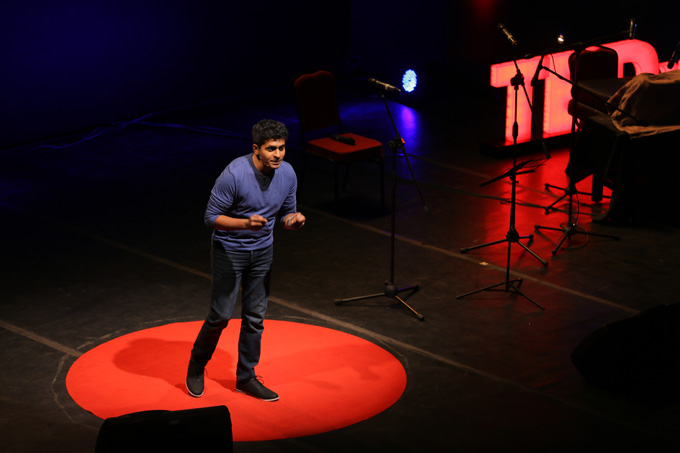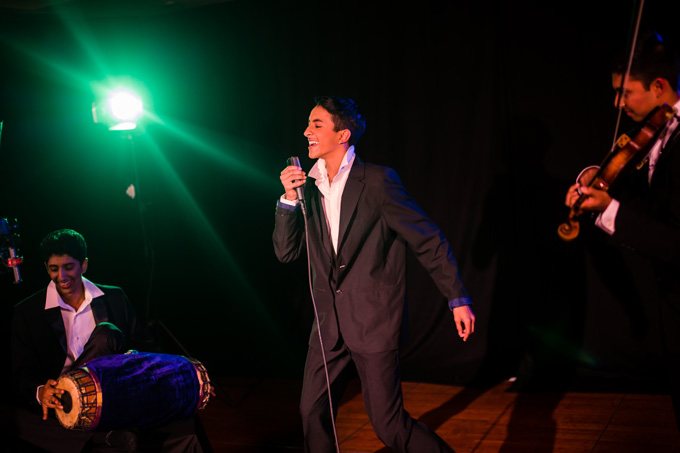Finding Common Sound
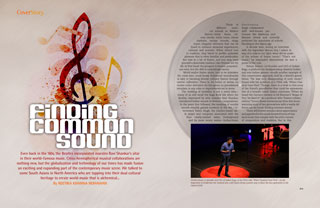
Even back in the ‘60s, the Beatles incorporated maestro Ravi Shankar’s sitar in their world-famous music. Cross-hemispherical musical collaborations are nothing new, but the globalization and technology of our times has made fusion an exciting and expanding part of the contemporary music scene. We talked to some South Asians in North America who are tapping into their dual cultural heritage to create world music that is alchemical...
Think of different musical sounds as distinct flavors—briny beats, citrusy chords, nutty notes, robust rhythms, syrupy sounds, tangy tones—singular elements that can be fused to enhance sensorial experiences, culinary and acoustic. When stirred true to tradition, they blend to proffer palatable pleasure that is often familiar and predictable. But toss in a bit of fusion, and you may have yourself a delectable creation. Like Chinese stir-fry idli. At first blush the prospect is bizarre, preposterous even, but the dish is surprisingly savory.
World and/or fusion music (not to be mistaken for cross-over, vocal-heavy Bollywood soundtracks) is akin to blending diverse culinary flavors through careful calibration. There is, for better or worse, no cookie-cutter definition for this genre, no preordained template, or any rules or requirements set in stone.
The melding of melodies is not a novel idea—many of us will recall the Raga Rock 60s when the Beatles, impressed by sitar maestro Ravi Shankar, introduced Indian sounds in Western compositions. In the years that followed, the meshing of sundry sounds steadily gained currency. In the 90s, I interviewed Talvin Singh, the London-based tabla player and composer associated with the then newly-minted Asian Underground and its more recent avatar—Indian/Asian Electronica. Singh collaborated with well-known performers like Madonna and Massive Attack and correctly predicted the popularity of eclectic blending in the digital age.
A decade later, during an interview with the legendary Manna Dey, I asked, in way of a coda to our Q&A: what did he make of the echoes of fusion music? “That’s not music,” he responded dismissively. He was a purist to the core.
|
|
|
Sriram Emani, co-founder and CEO of Indian Raga, at his TEDx talk, ‘When Classical Goes Viral’—on the imperative to modernize the classical arts, with fusion being a potent way to draw the new generation to the classical fold. |
Sriram Emani—co-founder and CEO of Indian Raga, a platform for amalgamating classical Indian and non-Indian genres—recalls another example of this conservative approach, held by a friend’s grandfather. “He was very disapproving of such music,” Emani tells his audience at a TEDx talk, ‘When Classical Goes Viral.’ Though, there is a twist to this story of the friend’s grandfather that could be representative of a broader trend. Emani continues, “When he heard the Carnatic version of Ed Sheeran’s ‘Shape of You,’ he liked it!” As a producer who “fosters collaborations,” Emani draws immense joy from this heartwarming story of two generations with a vastly different ear for music finding common sound.
There will forever remain a keen appreciation and appetite for the unadulterated forms of classical music that comply with the strict canons of composition and tradition. But in this age of high-tech, hyper-paced communing where traditions and techniques seep across increasingly porous boundaries between countries and cultures, the meshing of melodies is inevitable. Across that expansive euphonic mélange there are classically trained—Carnatic and Hindustani—musicians who step in time with likeminded peers from variegated disciplines to break new ground.
Emani, whose Indian Raga is now a byword for artistic experimentation, sums it up eloquently in his TEDx video. “Bringing down barriers to appreciation does not diminish the integrity of the art form. It only helps build small steps with which you can climb the ivory tower.”
Speaking of the ivory tower, not every passionate aspirant comes from a privileged musical background or has the wherewithal to experiment with music from diverse cultures. On the contrary, says Emani, “musicians chance upon it or have to spend disproportionate amounts of time and effort in trial and error to get it right.” His remedy? “[Introduce] this approach in the learning itself, just the way we have minors in undergrad—why not train in Carnatic classical, but also do a minor in Jazz? Not only is it immensely valuable to compare and contrast the styles of improvisation, but also to know what [is] the right way to fuse the sounds.”
When done right, it is rather fitting that “world music” has an amorphous, all-encompassing spirit—it speaks of a landscape as opposed to a pigeonhole. Tune in as we share our interactions with some innovative South Asian musicians steeped in fusion and world music.
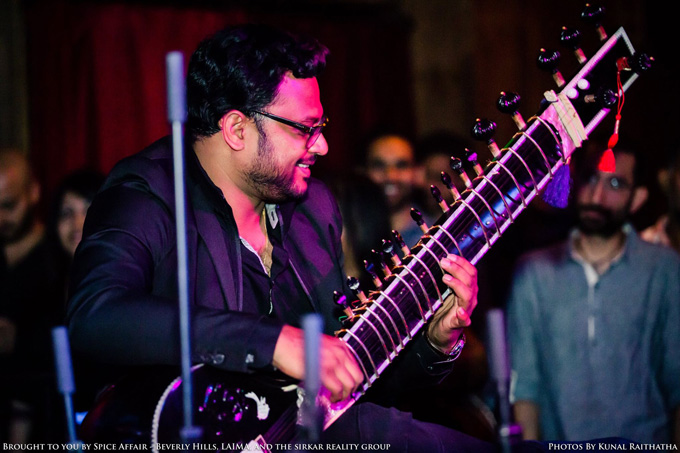
Rajib Karmakar is a third-generation musician trained in Hindustani, grew up under the legacy of Maihar Gharana, and has a Masters in Music from the California Institute of the Arts, where he learned various forms of world music such as Persian, African, and Balinese in addition to Music Technology.
Rajib Karmakar
Karmakar is the kind of musician who leaves a legacy that endures the test of time. A sitar maestro, he has the ability to jam and jive with venerated instrumentalists with facile ease. An L.A.-based composer, educator, and extensively-travelled musician with performances across India, USA, and Canada, he says, “I would love to work with Yanni, Yo-Yo Ma, Sting, and Slash from Guns n’ Roses.”
This Durgapur native and Rabindra Bharati University alumnus has a Masters in Music from the California Institute of the Arts, where he learned various forms of world music such as Persian, African, and Balinese in addition to Music Technology. “Being a student throughout life is the best thing to be,” he quips.
He is a third-generation musician in his family, whose journey as a musician began when he was four years old, training in Hindustani music with vocals. “I was trained in vocals and sitar by my father who learned in the Maihar Gharana (tradition of playing) and then learned Hindustani vocals from Ustad Ghulam Akbar Khan of Rampur Sahaswan Gharana, and thereafter, from Pt. Ramdas Chakraborty of Senia Gharana.” And the journey continues. “Throughout my career I learned thoughts and cultures of various parts of the world which enabled me to grow as a musician.”
His interest in world music began when he heard “Shakti”—featuring L. Shankar (violin), Ustad Zakir Hussain (tabla), Vikku Vinayakram (ghatam) and John McLaughlin (guitar). “It opened a new horizon to explore.” He describes his personal style of music as, “on one hand deep-rooted traditional Indian music and on the other a mix of various genres from around the world. I try to learn newer ideas from different genres and apply that in my storytelling through music.”
Speaking of times oncoming he predicts, “A diversified unity is in the making; newer forms of music, arts, and technology is the future.”
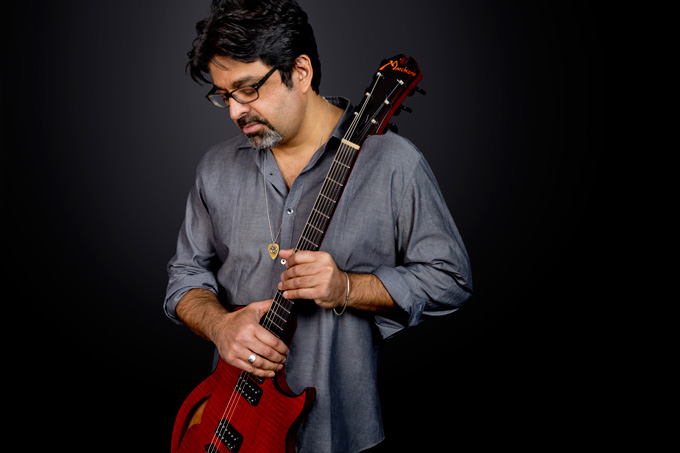
(Photo: John Rogers)
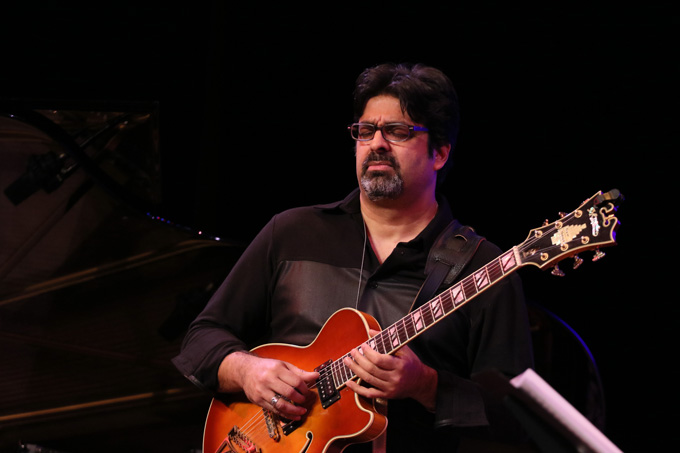
(Photo: Ellen Wallop).
When asked if he knew of any “dabblers” in the arena of world music, Rez Abbasi answered, “I don’t hang out with dabblers.” Abbasi speaks from a place of authenticity that calls for an understanding and respect for the pure genres before attempting any interspersing thereof.
Rez Abbasi
Jazz guitar player Abbasi’s appreciation for classical acoustics showcased through a filter of modern sensibilities is a delightful spectrum of sounds with commendable range. His compositions are eclectic and elegant in equal measure. Abbasi was voted #1 Rising Star Guitarist in the 2013 DownBeat Critics Poll and featured in the Top Ten Guitarist 2015 poll.
When asked if he knew of any “dabblers” in the arena of world music, he answered, “I don’t hang out with dabblers.” Abbasi speaks from a place of authenticity that calls for an understanding and respect for the pure genres before attempting any interspersing thereof. “If you don’t know about music that you may be influenced by, take time to investigate why you like it and want to incorporate it into your music.”
Tracing his roots, he says, “We migrated to the U.S. when I was four—I grew up an American with little reference to my heritage outside of the home. It was music (and food) that pushed me to explore my culture beyond the surface.” Abbasi attended USC (the University of Southern California) and later transferred to the Manhattan School of Music in NY to complete his undergraduate degree. “After that, I spent a couple of months studying the music and culture in India, where I met with Ustad Alla Rakha and started playing the tabla. That only lasted for a year because I found myself playing more tabla than guitar, so I had to stop...both are very demanding!”
A curator of alloyed sonance, when asked to describe his artistic style Abbasi says, “I never describe my music because I can’t; it’s sound to me and words only get in the way. To generalize, beyond saying it comes from jazz, I’ve had influences from rock, Indian classical, qawwali, Western classical, and so on... I’m open and therefore influenced on a daily basis. I’m not a purely traditional anything... I generally excel in hybrid music.” With no target audience or niche listeners in mind, Abbasi says, “I simply compose and hope for fans....”
His noteworthy collaborations include Rudresh Mahanthappa, Vijay Iyer, Sunny Jain, and Pawan Benjamin, but it would be safe to say his favorite collaborator of all is his wife, Kiran Ahluwalia.
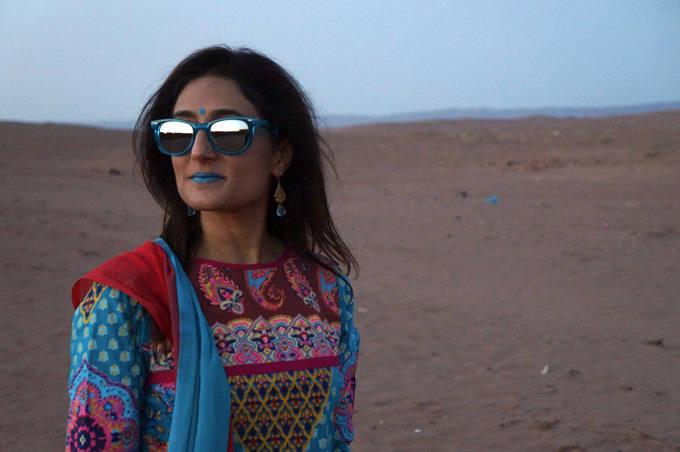
(Photo: Fernando Elizalde)
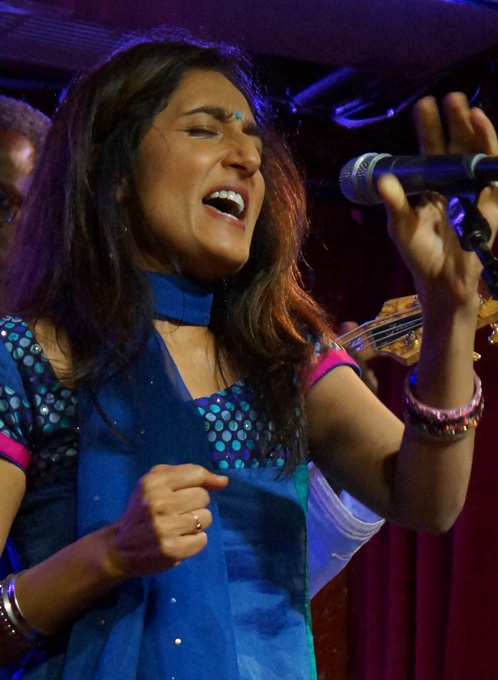
(Photo: Swathi Reddy).
Kiran Ahluwalia has taken aesthetics she loves such as Blues, African (Malian) music, and Indian forms and mashed them together in her own way.
Kiran Ahluwalia
Ahluwalia is a teller of tales. She uses her dulcet yet powerful voice to articulate the angst of the human condition—each story underscored by a captivating composition of blues, rock, R&B, and jazz. The instrumental backdrop plays a vital role in showcasing her lyrics that rise like labyrinthine zari work on a canvas of smooth silk.
Patna-born Ahluwalia grew up in New Delhi where her journey began as a musician. She credits her parents, “hobby singers,” as she called them, who “taught me shabad kirtan,” and set her up with formal music classes when she was five. “In the 70s my family immigrated to Canada, and my parents found an Indian music teacher in Toronto for me to continue with my music.” Through school, college, and her first 9-to-5 job, music remained a strong passion for Ahluwalia, albeit a part time endeavor. “After working for 2 years I made the decision to quit my job and go back to India to be a full time music student for one year. Everyone said I was crazy!”
For the following 10 years Ahluwalia bounced back and forth between music studies in India and earning an MBA in Toronto, ending up “trading bonds on Bay Street.” She eventually switched completely to music, still toggling between the two countries. “I would spend a year studying music in India, then return to Toronto to work for a year in radio, TV, or a record label.” The alternating phases and places continued until 2000 when she recorded her first commercial album. “Then I got a manager and an agent and started touring. Now I’m releasing my 7th album, 7 Billion.”
Like most immigrants of her ilk, the dichotomy of cultures presents its own challenges, but it also serves as a fertile ground for expression. “Culturally, I developed ways of doing things that were neither ‘fully’ Indian nor ‘fully’ Canadian. I want my music to be a reflection of my personality and so it’s quite organic for me to mix both Indian and Western ideas in my composing.” And like many of us who live in two worlds every day, she has developed a unique sensibility that allows her to view herself as part of something larger still. “Beyond my dual cultures I’m also a citizen of the world and I’m free to take aesthetics I like from all over the globe. I’m a modern exponent of the vocal traditions of India and Pakistan, which I both honor and depart from. I’ve taken aesthetics I love such as Blues, African (Malian) music, and Indian forms and mashed them together in my own way.” Speaking of her latest album 7 Billion, she says, “My lyrics are about cultural intolerance and the loss of brotherhood within the 7 billion of us on earth today.”
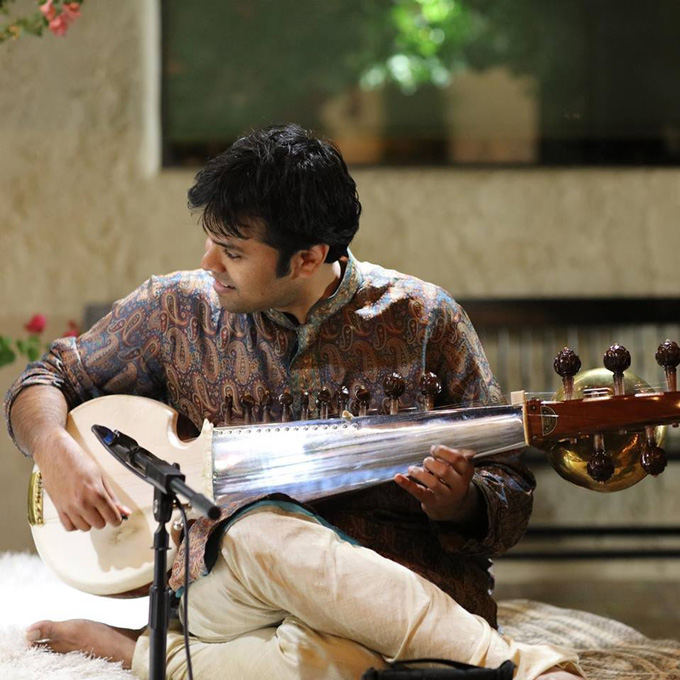
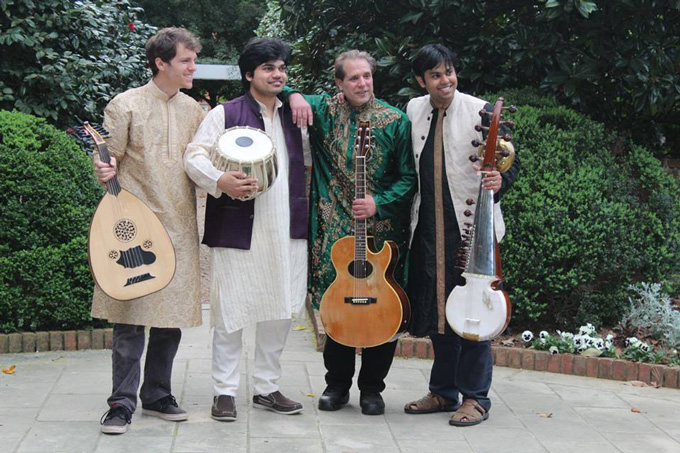
As a creative director of the 2015 IndianRaga Fellowship, Souryadeep Bhattacharyya spearheaded the critically acclaimed “Raga Trilogy.” He is also a member of Gypsy at Heart, an Athens, Georgia-based world music group.
Souryadeep Bhattacharyya
Bhattacharyya plucks the strings of the sarod with natural grace. His music is fluid, like cascading water rising to a crescendo as it swirls around rocks, seeking a more serene cadence when it slows to a gentle flow before plunging over a cliff in free falling melody.
“I see music in me,” Bhattacharyya recalls as he looks back at his younger self—a young musician who saw his reflection in the steel plate of the sarod. He remembers being too small to hold the plectrum (java) of the sarod with adequate strength, but he felt a kinship with the instrument nonetheless. “I thought of it as mini-me and over time this childhood affinity turned into an unbreakable bond with the instrument’s soul.”
Souryadeep constantly seeks to balance his strong inclination towards academic research with music. A chemical engineer from Georgia Institute of Technology, he has performed in many prestigious venues including the Lincoln Center in New York City. Souryadeep is a premier “ganda bandhan” disciple of the legendary sarod player Pt. Alok Lahiri. He speaks of his gurus with the kind of respect that harks to a bygone time when the guru-shishya bond was sacred and meaningful. His playing style of Indian classical music “mirrors that of my guru and I try to inculcate various aspects of the different gharanas of sarod into my recitals—an assimilation of these diverse gharanas.”
Bhattacharyya took the opportunity to explore the music world when he came to U.S. in 2012. “I was drawn towards various Western musical genres here,” he recalls. As a creative director of the 2015 IndianRaga Fellowship, he spearheaded the critically acclaimed “Raga Trilogy” that was the meshing of ringtones, jingles, and movie music into catchy classical renditions featuring a number of Western classical musicians.
He joined Gypsy at Heart, an Athens, Georgia-based world music group: “it is mainly through extensive performances as a member of this group—now its specialized trio Catalpa—that I have refined my abilities and skills as a world musician.”
Speaking of the necessary elements of collaborations, he cites “deep grounding in one’s own specific art form before exploring other genres actively—as only by being a true expert in your own form you can effectively collaborate with other experts creating music that respects and enhances each genre individually. At the end of the day, music is music; it is universal. It’s the same 12 notes played in different ways, whether you play it in Indian or Western music.”
Bhattacharyya elucidates, “For example, the sarod is tuned to one scale and I have to find creative ways to change scale within a composition. As an Indian classical musician, improvisation for me is built in, and I have found many good Western musicians, while excellent at reading off sheet music, struggling to improvise on their own. Conversely, a challenge for me is to stick to a said script when needed during performance pieces if parts are predefined, given my grounding in the relatively unstructured nature of Indian classical music. As musicians we all work together towards that sweet spot where everyone is comfortable and understands what the other musician brings to the table.”
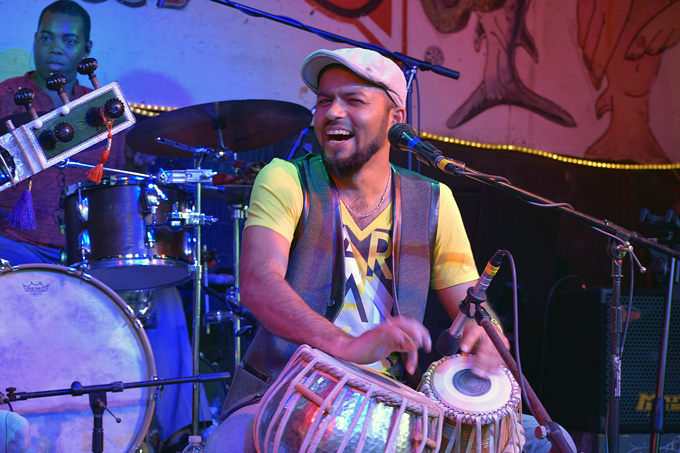
Shankh Lahiri founded the Wahh World Fusion Band, which has played at Rockwood Music Hall [in NYC] and the prestigious South by Southwest Festival in Austin.
Shankh Lahiri
Founder of the Wahh World Fusion Band, Lahiri orchestrates musical mosaics of instruments from across the globe with wizardly instincts conjuring soundscapes that stretch beyond the constructs of physical boundaries. Boisterous and brave, his compositions are an education delivered in rousing tempo.
“My father was a court musician for the king of Raniganj, and I grew up in a very traditional environment surrounded by music where my entire family were musicians.” He started out training in vocals, but when his voice began to crack around 9th grade, he moved to the tabla. Choosing to make music his profession, he spent a decade in Mumbai under the tutelage of Pt. Nayan Ghosh, while working as a studio musician in Bollywood where he got the opportunity to work with other musicians. “I became a residential percussionist at the Enigma, the nightclub,” he says with a laugh. “It was a little weird for a traditional musician to work there, but the exposure and experience was great. I got to jam with Western musicians. I developed a good ear and an understanding for what the rest of the world had a taste for. And I started composing fusion music.”
An opportunity to work for the Pt. Jasraj School in Tampa brought him to the U.S. where he was able to partner with like-minded musicians with ease, “as there is no hindrance of words in classical music.”
In 2010, Lahiri threw together the Wahh World Fusion Band, which now has two albums under its belt. “We tour, we have played at Rockwood Music Hall [in NYC] and in many festivals.” The band was invited to prestigious South by Southwest Festival in Austin this March. With the intent of preserving our invaluable heritage, Lahiri founded “Shruti, a nonprofit school where we organize workshops and do training. There is a strong Indian community in Tampa and we also have the support of the city.”
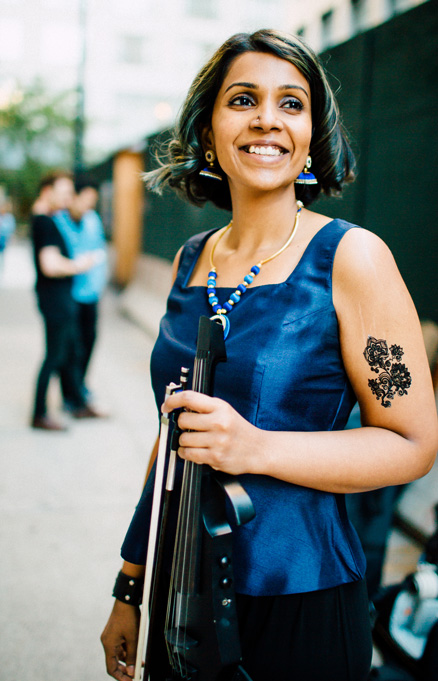
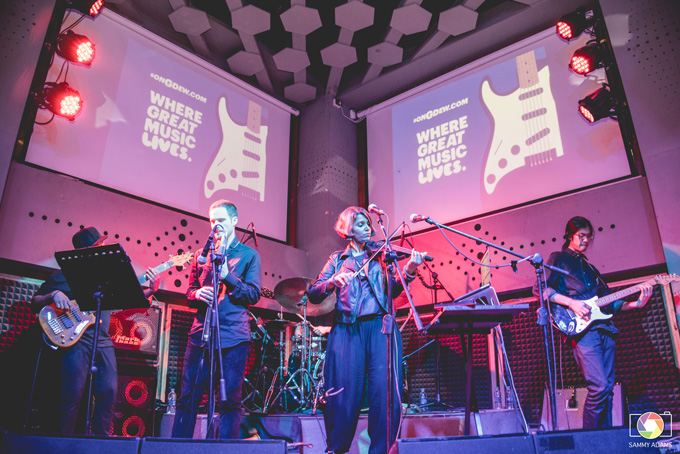
Harini S. Raghavan was inducted into the world of Carnatic music at a young age by her grandmother. Her hybrid music—powerful vocals and her masterful control of the violin synced to perfection with drums and sax—is fittingly defined as “Indian Electronica and Art Rock” under the banner of her band, Rini.
Rini S.
Harini S. Raghavan’s hybrid music—powerful vocals and her masterful control of the violin synced to perfection with drums and sax—is fittingly defined as “Indian Electronica and Art Rock” under the banner of her band, Rini. The track “Fear” with its cosmic invocation-esque opening followed by a rush of narrative vocals is a noteworthy example of her dense, essayistic compositions.
Born and raised in Chennai, Rini was inducted into the world of Carnatic music at a young age by her grandmother, a singer and violinist. “I was trained for 15 years,” she says. Her keen ear picked up film music and American popular music during her school and college days—she has a Masters in software engineering from India—and she began performing with various bands in Chennai.
Her big break came when she found herself a finalist on the Hariyudan Naan, a reality show featuring the famous singer Hariharan. A foot in the film industry and a jingle recording with the famed A. R. Rahman was validation enough for her to turn her passion into profession. In 2012, she earned a degree in Electronic Production and Design from Berklee College of Music, Boston, where she learnt Western classical singing, the violin, and other genres including Jazz and Musical Theatre. With a treasure trove of styles and sounds, Rini moved to New York and formed her band under her own moniker with Berklee alumni from around the world to create “a contemporary sound with Indian music as the soul.”
She describes her personal style as “Indian at the core—presented with influences from Electronica, Rock, and Jazz. Since Indian classical is my base, I always think of all music in terms of ragams, swarms, and rhythms at a technical level. The next layer is the emotion and style that comes in for delivering that particular music. So when I write music that includes different influences I weave it into the harmonies or chords—they follow a particular raga sometimes— or into the rhythm the drums play or in the electronic synths that are playing. The grooves are very Western, but the melody and supporting harmony can be very Indian.”
Delving deeper into the mechanics of melding melodies, she adds, “with respect to ragas and Western notes—the combination would be more with the Western chords. Indian classical music is traditionally monophonic—only one note at a time apart from the drone (tanpura). Western music brings in polyphony—multiple notes at a time. This makes it very interesting to create Indian melodies with Western harmonies that would work with the melody.”
Rini has collaborated with Israeli singer-songwriter Idan Raichel, and several native New York bands. Lately, she has been working with many on unique instruments like the Slovakian flute, and hulusi (Chinese flute). “You realize that you can bring about a harmonious blend from all these diverse sounds because, though music evolved separately in different regions of the world, there is so much in common, and musicians across the world can easily speak this language with each other. By fusing diverse music, I believe we will invent new genres and audiences for them, but the original traditional music will still be maintained in its pure form by those who prefer that. However, as humans evolve, our music is going to evolve, and in today’s global scene it will definitely be a mixture of diverse genres from our past.”
Rini currently writes music for the Facebook Sound Collection—a library of songs that any content creator can use for their video for free and post on Facebook/Instagram.
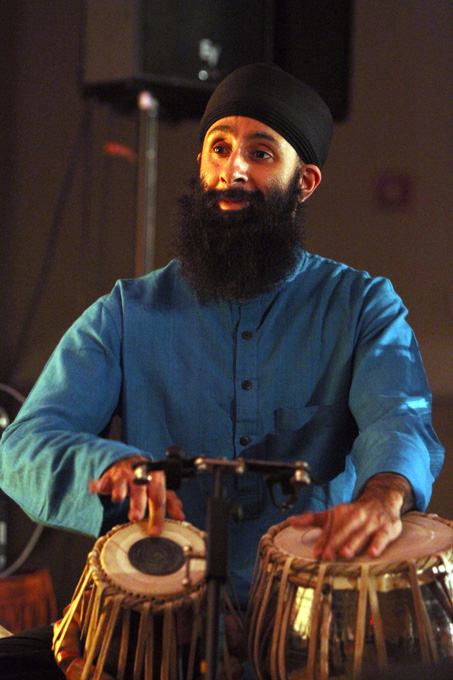
Indo-Canadian tabla exponent Neelamjit Dhillon is a student of Ustad Zakir Hussain. He uses harmonic frameworks based on raags to create modern music.
Neelamjit Dhillon
Grammy nominee Dhillon’s hands strike the tabla with an intuitive dexterity that takes the listener on a journey into a beautiful, wordless realm of rhythm. Listening to his tireless communion with the tabla, his devotion to music is evidenced by his incredible
talent. He accompanied Snatam Kaur, a world renowned Sikh sacred chant singer in her album Beloved that was nominated for a Grammy in 2018 under the
New Age category.
Canadian-born Dhillon started out playing the tabla at the gurdwara. At school, he played the saxophone and took lessons in Indian Classical music—tabla, sitar, bansuri, shehnai, and in Western music. His most noteworthy tutelage: “I have been a student of Ustad Zakir Hussain for the past 20 years.”
Speaking about the convergence of mores and melodies, he says, “Reconciling my hyphenated identity as an Indo-Canadian—music was my way through. Music has always been a confluence of various cultures and traditions. The music we commonly know as jazz came about in America from the melding of European, African, and Latin musicians. Even European classical music came from folk traditions and later became more and more codified. This (fusion/world) is no new concept, just a new application.”
Shining the light on his well-recognized work, he says, “I have devised original harmonic frameworks based on raags and utilize this original approach in my own music. I don’t think about the audience for any type of music I make. It is an artistic pursuit for me to express my unique identity. I would hope that my music will resonate with anyone that has a similar upbringing or anyone interested in understanding this facet of the human experience.”
There are many other South Asians doing wonderful work in world music. One finds serene solace in New York-based Chandrika Tandon’s Shivoham, three movements, twelve songs, an invitation to the “seekers of light” to embark on an enlightening journey on the wings of her melodies. One of The Brave Ones segments by CNBC introduces Tandon as “one of McKinsey’s best-known dealmakers who started her own investment business before a musical epiphany lead to a Grammy nomination,” (in the Best Contemporary World Music album 2010). Tandon has a remarkable talent to sift through the noise to cull distinctive sounds—Indian ragas, Gregorian chants, French café music, gospel choir, and more—and weave them together as a tribute to our common humanity across cultures, while celebrating her own heritage.
The limitless range of sounds in the arena of world music offers something for everyone. There is the edgy, futuristic, apocalyptic sounds of Turning Jewels into Water, “the deep-beat ceremonial think-tank that sees the coming together of percussionist/rhythm-prophet Ravish Momin and Haitian experimental electronic engineer Val Jeanty” bring into sharp focus the desolate fragmentation of the human spirit.
And somewhere in between are glorious performances by Anoushka Shankar, Pandit Ravi Shankar’s daughter, who takes her inherited genius to higher crescendos. Her sitar-guitar duet, a marriage of Indian classical with flamenco, “Boy meets Girl,” is the kind of sonic union that celebrates the distinct separation of the two genres with uncontrived grace.
|
|
|
2016 IndianRaga Fellows bringing together konnakol, mridangam and violin to Elvis’ “Blue Suede Shoes” to give it a crazy Carnatic touch! |
To Sriram Emani, it is no surprise as to why South Asians in North America are at the forefront of world music. “Diaspora kids grow up away from the mainland having a blended cultural experience where every aspect of their life infuses values, perspectives, and traditions from two or more cultures. It is natural for them to be able to have the full cultural experience of pursuing music that reflects and resonates with their various experiences.”
Reetika Khanna Nijhawan is an Atlanta based freelance writer, and author of Kismetwali & Other Stories. She writes to shine the light on the human spirit as articulated through creative, iconoclastic expression.
Enjoyed reading Khabar magazine? Subscribe to Khabar and get a full digital copy of this Indian-American community magazine.
blog comments powered by Disqus




